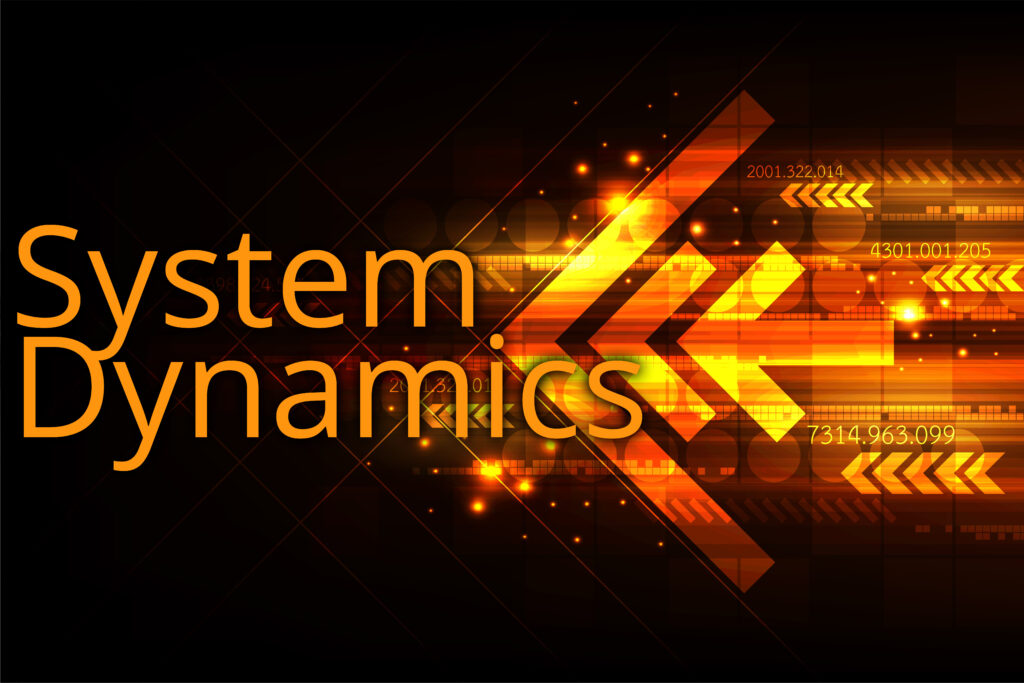What is System Dynamics?
In a world characterized by ceaseless motion, an intricate dance of cause and effect, the human desire to make sense of complexity emerges as a fundamental endeavor. System dynamics, a modeling and simulation approach pioneered by Jay W. Forrester, stands as a beacon in the misty landscape of intricate systems. As our interconnected networks sprawl across disciplines and borders, system dynamics offers a sturdy compass to navigate the labyrinth of relationships, tracing the threads that bind the tapestry of our world. This article delves into the heart of this powerful method, illuminating its five guiding stages and reflecting upon the myriad applications it serves. Join us in exploring the realm of system dynamics, as we uncover the tools to decipher the enigmatic language of complexity and chart a course towards a more profound understanding of the world that surrounds us.

1 – Problem Definition: Setting the Stage
The system dynamics process begins with a clear definition of the problem or issue that needs to be addressed. This essential step entails understanding the problem’s scope and context, as well as identifying the key variables that contribute to its existence. By defining the problem accurately, practitioners can focus their efforts on the most relevant aspects of the system and ensure that their analysis is targeted and effective.
2 – System Mapping: Visualizing Complexity
After defining the problem, the next step in the system dynamics approach is to create a visual representation of the system and its components. This process involves developing a system map, which illustrates the flow of information, resources, and feedback loops between the different elements of the system. System mapping plays a crucial role in understanding the underlying structure of the system and identifying key leverage points where interventions can be most impactful. This graphical representation aids in grasping complex relationships and simplifies the communication of system behavior to stakeholders.
3 – Model Formulation: Capturing System Behavior
With the system map in place, practitioners can proceed to develop a mathematical model representing the system’s behavior. This model captures the relationships between the various components of the system, allowing for a dynamic analysis of the system over time. As new data becomes available, the model can be continuously refined and updated to ensure accuracy and relevance.
4 – Simulation: Analyzing System Dynamics
Once the mathematical model has been established, practitioners can run simulations to study the system’s behavior and identify patterns or trends. These simulations can reveal potential side effects and unintended consequences of proposed interventions, allowing decision-makers to make more informed choices. Furthermore, simulations can help practitioners understand the long-term behavior of the system, identifying potential issues that may emerge in the future.
5 – Policy Analysis: Evaluating Interventions and Strategies
The final stage in the system dynamics approach is policy analysis. Here, practitioners use the simulation results to identify potential interventions and evaluate their impact on the system. This evaluation process includes assessing the effectiveness, feasibility, and cost of proposed interventions, as well as their potential impact on the system as a whole. Policy analysis enables decision-makers to compare various strategies and choose the most appropriate course of action to address the problem at hand.
Advantages of System Dynamics
System dynamics offers numerous advantages to engineers and decision-makers, providing valuable insights into the behavior and management of complex systems. Some of the key benefits include:
Comprehensive Understanding
System dynamics enables engineers to grasp the complexity and interdependencies of various system components. By creating a visual representation of the system and developing a mathematical model, engineers can identify the underlying structure of the system and understand how different components interact with each other (Forrester, 1961) [1]. This comprehensive understanding is crucial for effectively managing complex systems and addressing intricate problems.
Anticipation of Consequences
Simulations are an essential aspect of system dynamics, revealing potential side effects and unintended consequences of interventions (Sterman, 2000)[2]. By running simulations of the system, engineers can evaluate the impact of different policy options or management strategies and identify potential risks and opportunities. This foresight allows decision-makers to make more informed choices and design effective interventions that minimize negative consequences.
Identifying Leverage Points
System dynamics helps pinpoint high-impact areas for intervention or improvement (Meadows, 1999)[3]. By analyzing the system’s structure and behavior, engineers can identify key leverage points for intervention and design interventions that have the most significant impact on the system. This targeted approach ensures that resources and efforts are directed towards the most critical aspects of the system, maximizing the potential for positive change.
Long-Term Perspective
System dynamics emphasizes understanding long-term system behavior, allowing engineers to make informed decisions for the future (Forrester, 1971)[4]. By analyzing the system’s behavior over time, engineers can develop long-term strategies and policies that take into account the system’s dynamic nature. This focus on long-term planning is essential for creating sustainable solutions and addressing complex issues that span multiple time horizons.
Interdisciplinary Collaboration
System dynamics encourages collaboration across various disciplines, fostering a holistic understanding of complex problems (Richardson, 2013)[5]. By bringing together experts from different fields, engineers can develop a more comprehensive understanding of the system and design interventions that consider the system’s various components. This interdisciplinary approach promotes innovative solutions and ensures that all relevant aspects of the system are taken into account.
References
When to Use System Dynamics
System dynamics is a versatile approach that can be employed in a variety of contexts, from understanding complex systems and long-term planning to informing policy and management decisions and identifying system-level interventions. By leveraging this powerful tool, practitioners can develop more effective strategies and contribute to better decision-making in the face of increasingly complex challenges. It is particularly effective in the following scenarios:
Complex Systems are Involved
System dynamics is a powerful approach when dealing with interconnected systems, as it helps uncover the underlying structure and behavior of these complex environments. For example, system dynamics has been employed to identify the dynamics of environmental systems, such as ecosystems, watersheds, and climate systems [6]. This allows for a deeper understanding of the relationships between components and aids in predicting system responses to various changes.
Long-Term Planning is Required
Projects that require long-term perspectives and an understanding of system behavior over extended periods can greatly benefit from system dynamics. For instance, system dynamics has been used to analyze and plan for the long-term impacts of climate change on water resources [7]. By simulating various scenarios, practitioners can better anticipate future challenges and develop strategies to address them.
Policy or Management Decisions are Needed
When facing decisions related to policy options or management strategies, system dynamics can inform decision-making by simulating the impact of various alternatives. For example, system dynamics has been utilized to evaluate the potential impact of alternative transportation policies on traffic congestion [8]. This enables policymakers to compare different options and select the most effective course of action.
System-Level Interventions are Sought
When searching for leverage points to create systemic change, system dynamics can provide valuable insights. For instance, system dynamics has been applied to analyze the potential impact of renewable energy policies on reducing greenhouse gas emissions [9]. This helps identify the most effective points for intervention, ultimately contributing to more sustainable and impactful solutions.
Situations Where System Dynamics Might Not be Effective
While system dynamics can be beneficial in many cases, there are some situations where it may not be the most suitable approach:
Simple, Linear Problems
For problems with a clear cause and effect relationship and minimal feedback, system dynamics might be overly complex. In such cases, simpler models or approaches might be more effective.
Short-Term Projects
The focus on long-term system behavior might not be as useful for projects with immediate, short-term goals. In such cases, other modeling or simulation approaches might be more effective.
Lack of Data
System dynamics relies on data to create accurate models; if data is scarce or unreliable, the effectiveness of the approach may be limited. In such cases, other data-driven approaches might be more effective.
User-Centered Design Challenges
In cases where the primary focus is on understanding and addressing individual user needs, a human-centered design approach might be more appropriate. For example, system dynamics might not be the best approach to designing a user-friendly smartphone app.
Resource Constraints
Developing and running system dynamics models can be time-consuming and resource-intensive, making it less suitable for projects with tight deadlines or limited resources. In such cases, simpler modeling or simulation approaches might be more effective.

Linear Analysis
The methodology most opposite to system dynamics is linear analysis. Linear analysis refers to the study of systems with a simplified approach, where components and relationships are assumed to be fixed, constant, or linear over time. This methodology is often used to analyze problems that are relatively simple, have few variables, and do not involve significant feedback loops or time delays.
While linear analysis can be useful for understanding simple systems and making short-term predictions, it fails to capture the complexity, interdependencies, and dynamic behavior inherent in many real-world systems. In contrast, system dynamics focuses on understanding the nonlinear relationships, feedback loops, and time delays that shape the behavior of complex systems over time. By accounting for these factors, system dynamics provides a more comprehensive and accurate understanding of system behavior, making it better suited for addressing intricate and dynamic challenges.
| Aspect | System Dynamics | Linear Analysis |
|---|---|---|
| Complexity | Handles complex systems with multiple variables and feedback loops. | Simplified approach, best suited for systems with few variables and minimal interactions. |
| Relationships | Captures nonlinear relationships between variables. | Assumes linear relationships between variables. |
| Feedback Loops | Considers feedback loops and their impact on system behavior. | Ignores feedback loops, assuming constant relationships. |
| Time Delays | Incorporates time delays and their effect on system dynamics. | Does not account for time delays in system behavior. |
| System Behavior | Focuses on the understanding of dynamic and emergent behaviors in systems. | Assumes static or constant behaviors in systems. |
| Long-term Predictions | Suitable for long-term predictions and planning due to its dynamic nature. | Limited in making long-term predictions, best for short-term analysis. |
| Problem-solving Approach | Holistic approach, analyzing the system as a whole. | Reductionist approach, breaking the system into smaller, independent parts. |
| Application Scope | Widely applicable to various fields, including engineering, economics, ecology, and social sciences. | Primarily used in fields where systems exhibit simple, linear behavior. |
| Decision-making Support | Provides insights for policy analysis and system-level interventions. | Limited in its ability to support policy analysis and system-level interventions due to its simplified nature. |
Conclusion
System dynamics is a powerful tool for engineers to understand and analyze complex systems. By modeling and simulating system behavior, engineers can identify key leverage points for intervention and design interventions that have the most significant impact on the system. System dynamics provides a comprehensive understanding of system behavior and interdependencies, anticipating consequences, identifying leverage points, and a long-term perspective that can be used in various fields, such as management, policy, economics, environmental issues, and engineering. However, it may not be the most effective approach for simple, linear problems, short-term projects, lack of data, user-centered design challenges, and resource constraints. Engineers should carefully consider the strengths and limitations of system dynamics when deciding whether to use this approach in their projects.






